|
Acrylic:
Is a type of thermoplastic. Most common are
Lucite
and Plexiglass. Acrylic can be opaque or translucent and it
comes in many colors. |
|
Adamantine:
Inflexible. Like a diamond in hardness and luster. |
|
Adularia:
A translucent white and blue moonstone popular in
Art
Nouveau jewelry. |
|
African Emerald:
A
green fluorspar mined in South Africa. It is not an
Emerald. |
|
African Jade:
A large
green grossular garnet mined in South Africa. It is
not
jade. |
|
Agate:
A type or chalcedony quartz that forms in
concentric layers. Found in a variety of colors and very
common in jewelry. |
|
Alabaster:
A form of
mineral gypsum that can be used for beads. |
|
Alexandrite:
A
gemstone named after Alexander tsar of Russia. Rare and very
old, [discovered in 1830] it is known for the way it appears to change colors
under different sources of light. Some say it is the
rarest gemstone of them all. It is a
chrysoberyl that
is also made up of chronium. |
|
Alloy: Combination of
two or more metals. Some found in jewelry are sterling
mixed with copper. Others include;
pot metal, pewter,
bronze. |
|
Almandine: Is an iron
aluminum silicate. It is the most common of the Garnets.
Typically red to brown. |
|
Alpaca: An alloy of
copper, zinc and nickel that is used as a silver
substitute. Also called "nickel silver". |
|
Aluminum:
A
lightweight metal used in alloys and found in
Bauxite. |
|
Amber: A fossil resin
from conifer trees, that is translucent, hard and yellow
brown in color. Amber can be other colors such as off-white,
blue and black. Color depends on the depth of the water into
which the tree fell into the sea during the Glacier Age. It is flammable and it produces static
electricity. |
|
American Ruby: Is
actually a garnet and less expensive than a ruby. |
|
Amethyst: Is a quartz
that comes in a color range from light purple to deep
violet. The deeper the color, the more valuable. February
birthstone. |
|
Ametrine: A
combination of citrine and amethyst. This quartz appears
purple and orange. |
|
Amorphous: A gem that
does not have a consistent internal structure. Examples
include amber, jet and ivory. |
|
Amphibole: A rock
forming mineral composed of magnesium-iron silicates with
traces of other elements. |
|
Amulet: A charm worn
for good luck or to ward off evil. |
|
Angelskin Coral: A
pale pink coral. One of the most expensive. |
Anklet:
Jewelry worn
around the ankle.
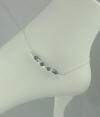 |
|
Annulus: A flattened
ring. Usually seen in a compact. |
|
Anodized:
A process for coloring metal with an oxide finish using
and electric current. |
|
Antique Jewelry:
Jewelry that is over 100 years old. |
|
Antiqued:
Process of changing a piece of jewelry to
make it look old. |
|
Antiquing: Process of
darkening the recessed areas of silver or
gold to enhance
engraving. |
|
Apple Juice: A golden
yellow translucent plastic. |
|
Appliqué: A separately
made ornamental object applied to a piece of jewelry. |
|
Aqua Aura: Iridescent
bluish to clear stone that is made by coating clear quartz
with a fine layer of gold, aluminum or
copper. |
|
Aquamarine: A light
sky blue to sea green gem that is a member of the Beryl
family that also includes emeralds. |
|
Aqua Regia: A
substance used to test platinum and gold . One of few
substances that can dissolve both it consists of
hydrochloric acid and nitric acid. |
|
Arcade Setting: A
style of setting where a stone is held in a metal ring
by several metal claws. |
|
Arkansas Stone: Used
to smooth metal in the jewelry making process. |
Art Deco: A style that
originated in Paris, France in the 1910s that incorporated
geometric shapes bold colors and angles. The name
derives from the 1925 Paris Exposition. Its
popularity waned in the 1930s.
 An amalgamation of many styles including; Cubism, Modernism, Constructivist, Bauhaus, Futurism and Art Nouveau.
An amalgamation of many styles including; Cubism, Modernism, Constructivist, Bauhaus, Futurism and Art Nouveau. |
|
Duette From Coro |
|
Art Moderne: A style
that evolved from Art Deco. While Deco was delicate Moderne
was blocky. Also known as Modernism. |
|
Art Nouveau: An
international style of art that incorporates curvy lines, florals,
plus natural themes and colors. Popular from the late 19th
Century to the early 20th Century. This movement in art was
seen as a rejection of the embellished style of the prior
eras. A short lived period of artistic discontent and
change. Replaced by Art Deco. |
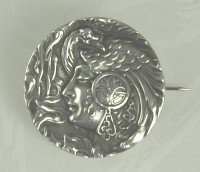 |
|
Unger Brothers Art Nouveau Pin in Sterling |
|
Articulated:
Flexible jewelry constructed with hinges. |
|
Arts and Crafts: A
design movement that rejected the opulence of the Victorian
designs in favor of good craftsmanship, simplicity and good
design. Began in the late 1800s. |
|
Assay: A test to
determine the purity of an alloy. |
|
Asscher Cut: A cut of
diamond popular in Art Deco jewelry. It was the forerunner
to the emerald cut. Invented by Joseph Asscher,
diamond cutter from Amsterdam. |
|
Asterism: A star
shaped light that reflects from some gemstones. |
|
ATW: Approximate Total
Weight, measured in carats, of a gemstone. |
Aurora Borealis: Means
Northern Lights. AB rhinestones have a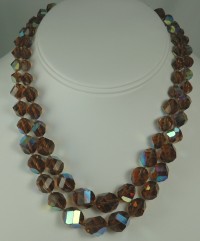 special finish that
is iridescent. A thin layer of metallic atoms are deposited
at the lower levels of the stone causes the stone to show
several colors. This process was developed
in 1955 by Daniel Swarovski and Christian Dior.
special finish that
is iridescent. A thin layer of metallic atoms are deposited
at the lower levels of the stone causes the stone to show
several colors. This process was developed
in 1955 by Daniel Swarovski and Christian Dior. |
|
Austrian Crystal:
Lead crystal cut to precise angles at the Swarovski
factory in Wattens in the Austrian Tyrols.
Known for their quality. These days not all Austrian
crystal is made by Swarovski. |
|
Aventurine: Is a
quartz that shimmers The shimmer is caused by tiny mica or
metallic particles in the stone. Also called Goldstone.
Ranges in color from yellow to light green. |
|
Aventurine Feldspar: A
metallic looking gemstone that is also called Sunstone. It
ranges in color from gold-ish orange to red-brown. |
|
Aventurine Glass:
Invented in Venice Italy in 1700 this is a glass that
shimmers because of tiny flecks of copper imbedded within. |
|
Aventurine Quartz: A
type of quartz that has inclusions of mica or
iron. |
|
Awabi Pearl: The
Japanese name for pearls found in Abalone Mollusks. |
|
Axinite: Is a dichroic,
boro-silicate of aluminum and calcium, stone that is
lustrous and has translucent as well as transparent
varieties. |
|
Axis of Symmetry: Also
known as the rotational axis. It is when an imaginary
line passes through an object in such a way that part of the
figure on one side of the line is a mirror image of the part
on the other side of the line. When two planes of symmetry
intersect, they form a straight line. This line is an axis
of symmetry. Jewelers use this to grade stones. |
|
Azurite: A copper
based blue mineral. It is often used in jewelry. Azurite is
hydrated copper carbonate. |
|
|
|
B |
|
Baffa Diamond: Is not
a diamond but rather rock crystal. |
|
Baguette:
French for rod or stick. A stone most usually a diamond that
is cut into a narrow rectangular shape.
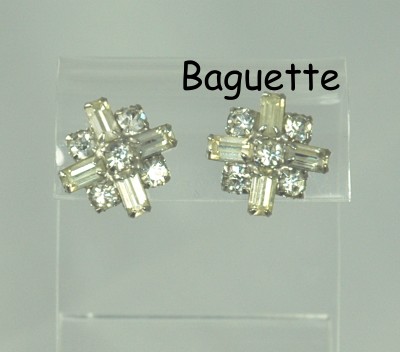 |
|
Bail: A jewelry
finding that is usually triangular and attaches a piece of
jewelry to a cord or a chain. |
Bakelite:
A trade name for a dense
synthetic resin [plastic] that can be molded,
extruded or carved. It is made from carbolic acid and
formaldehyde. Jewelry made from bakelite is molded and has no seams. This
plastic was developed by L.H. Baekeland, a Belgian chemist,
in 1909. A thermoset plastic.
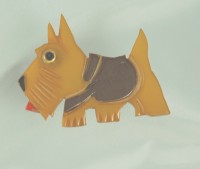 |
|
Bakelite Scotty Dog with Glass Eye |
|
Balls: Similar to
beads except they have one hole that usually attaches to a
post. Found mostly in Body Jewelry. |
|
Band: A ring made from
a flat strip of metal. A wedding ring is a band. |
|
Banded Agate: An Agate
with several distinct layers of color. |
Bangle: A stiff
bracelet solid or hinged. If is solid it must be slipped
over the hand.
 |
|
Diamonbar Sterling and Crystal Bangle |
|
Bar and Ring
Clasp: A jewelry closure. Also known as a toggle
clasp. A bar is inserted into a ring to secure the jewelry.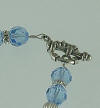 |
|
Barbells: Body jewelry
that has two round balls at either end of a pipe, resembling
a "barbell". |
|
Baroque: A term that
refers to irregularly-shaped stones or pearls. |
|
Baroque Pearls:
Irregularly shaped pearls that can be natural
or man-made.
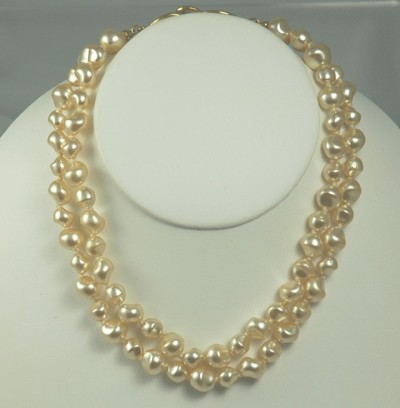 |
|
Kenneth Jay Lane Choker |
|
Bar Pin: A long and
narrow pin. Also known as a bar brooch. |
|
Barrel Clasp: A
closure that looks like a barrel. One end screws into the
other end to secure the jewelry. |
Barrette: An adornment
worn in the hair. It is clipped into the hair. |
|
Taxco Mexican Sterling Barrette |
|
Basalt: A dark glassy
fine grained volcanic rock. |
|
Base Metal:
Non-precious metals such as steel, zinc, lead, tin and copper.
Used as the core for plating. |
|
Basket Setting: A lacy
looking setting that has holes in the side and is similar to
the basket weave. |
|
Basse-Taille: A
technique where the underlying metal is carved in low relief
and translucent enamels are applied allowing the carved
design to remain visible through the enameling. |
|
Baton: A diamond or
stone that has been cut in a long rectangular shape. |
|
Bauhaus:
An art movement that began in Germany around
1919. The movement was concerned with simplicity, form and
the belief that science and technology could lead to
personal freedom and prosperity.
Art Deco is a design style within Bauhaus. |
|
Bauxite:
The principal
ore in aluminum. It a sedimentary rock produced by chemical weathering typically under tropical to
subtropical climate conditions. It is naturally occurring. |
|
Bayadère: A
multi-strand pearl necklace with twisted strands. |
|
Beads: Beads are small
objects, usually circular, that have a hole on either side
allowing a string to pass through. Beads can be made of
several materials including; glass, ceramic, stone, plastic,
seed and wood. |
|
Belle Epoque: French
for "Beautiful Time" it was the period of 1901-1910 during the
reign of Edward VII of England. This period is known as the
"Edwardian" period. |
|
Belly Chain:
Body jewelry that is worn around the
waist. |
|
Belly Ring: Body
jewelry pierced or clip-on that is worn in the belly button. |
|
Beryl: A hard mineral
that comes in a variety of colors. Gemstones included in
this family are; emeralds and aquamarine. |
|
Beveled: A type of
surface cut that is at an angle less than 90 degrees. |
|
Bezel:
Also known as
the crown, the bezel is the part of the stone that extends
beyond the top of the setting. |
Bezel Setting: A type
of setting where the stone is held in place by a metal
band on the outside of the stone.  |
|
Swarovski and Sterling Anklet with Bezel Set Dangles |
|
|
|
Bib Necklace:
A short
necklace with multiple dangles. |
|
Birthstone: A gemstone
used to represent a particular month.
See Chart |
|
Black Hills Gold: Gold
jewelry made in the Black Hills area of South Dakota, USA.
It is usually yellow gold, pink gold and green gold in a
grape and vine motif. This jewelry is usually 10 Karat gold. |
|
Black Moonstone: A
black moonstone is actually a labradorite [a type of
plagioclase feldspar]- a grayish mineral that shows flashes
of color, usually green, blue or red after being polished. |
|
Black Onyx:
An onyx
with a dark opaque body.
|
|
Black Opal: An opal
with a dark gray body that is highly coveted. They are very
brilliant and show many colors. |
|
Black Pearl:
Also
known as Tahitian pearls they have a dark nacre. They come
in a variety of colors including eggplant, peacock green and
deep brown. The peacock green is the most sought after.
|
|
Bleaching:
A process of removing a gemstones color. |
|
Blemish: A flaw on the
surface of a stone. |
|
Blister Pearl: Most
often used for earrings a blister pearl forms attached to
the shell of the mollusk and has to be cut off, leaving it
domed with a flat side. |
|
Bloodstone:
A form of
chalcedony that is green with red highlights, soft and
porous. |
|
Blue Diamond: Are
rare, expensive fancy diamonds that are blue. |
|
Blue Gold: Gold with a
bluish tinge. |
|
Blue Topaz: A topaz
that was mined brown or colorless then exposed to heat which
turns it blue. |
|
Bodkin: A hairpin, from
the
Renaissance Era, that was heavily jeweled. |
|
Body Jewelry: Jewelry
worn on or in a part of the body usually through piercing. |
Bog -Oak:
Used in
inexpensive
Victorian jewelry, Bog-Oak is a white Oak that
has been darkened and preserved by being buried in a bog.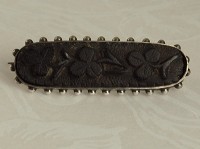 It is lightweight.
It is lightweight. |
|
Antique Bog Oak Pin with Shamrocks in
Sterling |
|
|
|
Bohemian Diamond:
Really a rock crystal rather than a diamond. |
|
Bohemian Garnet: A
pyrope garnet very deep red in color that was used in
many pieces of Victorian jewelry. They are said to have
curative powers. Named for the region in which it was found. |
 |
|
Victorian Rose Cut Bohemian Garnet Bar Pin |
|
|
|
Bohemian Ruby: It is
not a ruby but rather a pyrope garnet - deep red in color. |
|
Bolo: A necktie often
made of leather that is adorned and fastened with a
decorative slide. |
|
Bolt Ring: Used to
attach two links of a bracelet or necklace. Also known as a
Spring Ring it was invented in the 1900s. |
|
Bombé: A domed shaped
seen in earrings and rings in the 1940s and 1950s. |
|
Bonding: A process of
applying a colorless bonding agent into or on a gemstone to
make the stone more robust. |
|
Bone:
Hard tissue from an animal. It is
porous with grain lines that run in one direction. White or
off- white in color and it is brittle. |
|
Book Chain: A metal
chain, dating back to the Victorian Era, with rectangular
links folded to resemble a book. 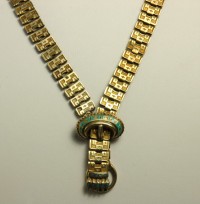 |
|
Gold- filled Book Chain Necklace |
|
|
|
Bort: An industrial
grade diamond. |
|
Botanical Gems: Are
minerals that form from plant material. Amber is a botanical
gem. |
|
Bouton Pearl: See
Blister Pearl |
Bracelet: A form of
jewelry worn wrapped around the wrist.
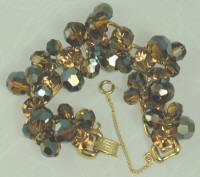 |
|
De Lizza and Elster Juliana 5 Link Bracelet |
|
|
|
Brass: An alloy of
copper and zinc. |
|
Brilliance: Is the
amount of sparkle caused by light reflecting off the facets
of a gemstone. |
|
Brilliant Cut:
Introduced in the 1600s, the brilliant cut has 56 facets to
maximize the amount of light reflected from the stone. |
|
Bridge Jewelry:
Jewelry that falls between fine and costume such as sterling
silver jewelry. |
|
Briolette: A pear
shaped cut often used for pendants. |
Brooch: A brooch is an
ornamental item of jewelry that is pinned to a
garment.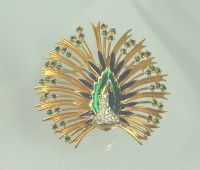 |
|
Jomaz Rhinestone and Enamel Peacock Brooch |
|
|
|
Bronze:
A dense alloy
containing at least 60% copper and other metals. |
|
Brushed Finish:
A
finish that is produced by rubbing the surface of metal with
a stiff metal brush. This finish ads texture and makes the
surface of the metal less reflective.
Other finishes. |
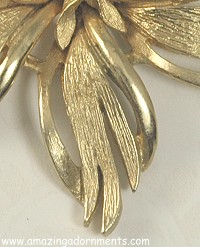 |
|
Brushed Gold- tone Metal at the Center
|
|
|
|
Bruting: The first
step in cutting a diamond. Gives the gem it's basic shape. |
|
Bubbles: Tear shaped
gases that are captured in a glass stone. |
|
Burnish Setting: A
setting where the stone is set flush with the setting
without prongs to hold it. |
|
Bugle Bead: A long and
thin glass bead that is tubular. |
|
Bulla: A Roman pendant
worn around the neck that contained a good luck charm.
It was usually round and worn by the Roman youth until
adulthood. |
|
Buttercup Setting: A
six prong setting that is deep and flared resembling a
buttercup. |
|
Butterfly Clutch:
Slides onto the back of an earring post securing it on
the ear. |
Butterfly Wing Jewelry:
Jewelry made from real butterfly wings, usually
includes a painted picture.
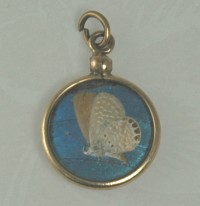 |
|
Button Earring: An
earring that does not dangle. |
|
Byzantine Chain: An
intricate chain where two pairs of ovals are linked and then
parted allowing a larger oval link to be attached. |
|
C |
|
"C" Clasp: Dating to the
before the 1900s this type of catch had a pin rod that was slipped under a
lip that looked like the letter "C." There are a
few types of these catches. The open "C" catch had no
mechanism to lock the rod in place. The rod extended beyond the
clasp so that the wearer could use the extra [extended portion]
pin rod to secure the pin to their clothing. |
|
Cable Chain: The most
common chain it is a series of same sized round links. |
|
Cabochon: A rounded
domed stone without facets. From the French "caboche"
meaning small dome. |
|
|
|
Cairngorm: Used in
traditional Celtic jewelry it is a yellowish brown smoky
quartz. Almost extinct. |
|
Calar: To pierce or
cut a piece of metal creating a design. |
|
Calcite: Calcium
Carbonate is a mineral that is variable in color and form.
It has a white streak and is brittle. It is translucent to
transparent. It is found in abundance in
limestone and marbles. |
|
Calibre-Cut: Small
stones that usually have step-cut facets. They are usually
rectangular in shape. |
|
California Ruby: Is
not a ruby. It is a pyrope garnet. |
|
Calsilica: This is a
newly found multi-layered stone used for beads and carvings.
Often called rainbow calsilica it is comprised of calcium
and silica. |
Cameo: A method of
carving in which the stone around a design is carved leaving
a relief design above the surface. The background is usually
in a contrasting color. Cameos are usually carved from
shell, coral and other hard stones. Imitation cameos
can be found in plastic.
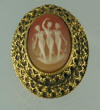 |
|
Vintage Three Graces Shell Cameo |
|
Cameo Habille: From
the French meaning "dressed cameo" a cameo habille is a
cameo in which the subject of the cameo is wearing a small
piece of jewelry like a diamond chip. |
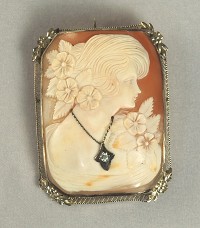 |
|
Antique 14k Cameo Habille |
|
Camphor Glass: Popular
in the mid-nineteenth century it is a cloudy white glass
that is blown or pressed. |
|
Canary Diamond: A
diamond that has a deep yellow color. |
|
Cannetille: A filigree
type of design using coiled and twisted gold wire. |
|
Cape Amethyst: A
translucent gemstone that has a color range from light to
medium purple with white bands or milky quartz. |
|
Cape Ruby: Is actually
a pyrope garnet and not a ruby. |
|
Carat: [ct.] The
standard of measure of weight for a gemstone
introduced in 1907. One carat weighs 0.2 gram -1/5 of a gram
or 0.0007 ounce. The relationship between size and
weight varies among gemstones because gemstones have
different specific gravity. For example a one carat ruby
will be smaller than a one carat diamond. |
|
Carbon: The sixth most
common element in the universe it is a nonmetallic,
tetravalent element, carbon has several allotropic forms
such as diamonds and graphite, the hardest and one of
the softest elements. Carbon is easily bonded to other
materials as well as itself. |
|
Carbon Spots: A
diamond is carbon that has been compressed. Carbon spots are
black deposits or inclusions that can be seen inside the
stone. |
|
Carbonado: A type of
black opaque diamond not used for jewelry that is usually
found in irregular fragments. It is used for drill bits and
it is very rare. |
|
Carbuncle: A garnet
cabochon. |
|
Carnelian: A
translucent orange/reddish type of
Chalcedony. An A-grade agate, it was once and still is
thought to have healing powers.
Deposits of this gemstone are found in
Australia
Brazil, India, Russia, Madagascar, South
Africa, Uruguay and the U.S.A. |
|
Carry All:
A type of hard case compact that was popular
in the 1950s and the 1060s. They usually had
compartments for lipstick, powder and such. |
|
Casein:
A plastic made from milk proteins and
formaldehyde. Develpoped by German Scientist Dr. Adolph
Spitteler. Trade name: Galalith. Material was used for
jewerly during the Art Deco era, especailly in Europe.
|
|
Casting:
Shaping or
founding of metal by pouring into a mold. There are
different forms of casting such as lost wax process,
centrifugal [also known as
investment] casting, and sand casting. |
|
Catalin:
A plastic
that allows for a wide range of color [unlike
Bakelite] that became popular in
the Art Deco Period. |
|
Cathedral Setting: A
type of ring setting that arches like a cathedral when
viewed from the side. |
|
Cat's
Eye: A prominent streak of light along a
cabochon that is said to look like
a pupil. Gems such as
chalcedony and chrysoberyl that reflect light.
|
|
Celluloid:
A plastic
invented in 1869, made from cellulose , a natural plant
fiber. Highly flammable and can be damaged by moisture. It
was developed to replace ivory being used for billiard
balls. Used for jewelry and hair combs. |
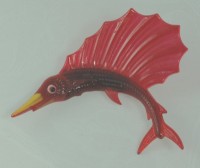 |
|
Celluloid Sail Fish |
|
Cellulose Acetate:
Plastic made from cellulose fiber that has been treated with
acetic acid. Replaced celluloid in jewelry making as
cellulose acetate is not flammable. Available in a
wide range of colors. |
|
Celtic Jewelry:
Jewelry made by the Celts in Wales, Scotland, Ireland and
Brittany using gold, bronze and silver. The Celts also used
stones such as Amethyst. The oldest
example goes back to 700 A.D. |
|
Celtic Revival:
Jewelry made in the nineteenth century imitating jewelry
made in early Ireland. |
|
Center Stone: Usually
the prominent stone in a ring setting. |
|
Centrifugal Casting: A method of casting jewelry
using tubes and centrifugal force to force molten metal into
molds. |
|
Certification: A
blueprint of sorts that describes the characteristics and
quality rating of a stone. |
|
CFW: An abbreviation
for Cultured Fresh Water Pearls. |
|
Chain: A strand of
linked loops, beads or rings that are used for necklaces and
bracelets that includes Rope, Cuban, Figaro to name a few. |
|
Chalcedony: A family of minerals
including
agate,
onyx, carnelian,
cat's eye, and jasper that
have a milky to
gray/blue or waxy luster.
It is translucent and porous. When chalcedony is variegated,
has spots or is arranged in different layers of color it is
known as agate. When it can, because of thickness, or by
arrangement of the layers, be used to carve
cameos it is known as onyx. |
|
Champagne Diamond: A
pinkish brown diamond mostly mined in Australia. The color
comes from their low nitrogen content. |
|
Champlevé: Method of
applying enamel to metal in which engraved grooves are
filled with enamel and then polished. |
|
Chandelier Earrings: A
type of earring whereby a drop is suspended from a finding
that looks like a chandelier. |
|
Channel Set: A jewelry
setting in which the stone sits in a metal channel or groove
and is held in place by the thin rim of the setting. Most
channel set stones are rounds or baguettes. Contrast with
prong set jewelry. |
|
Chaplet: A wreath or
garland worn on the head and usually made out of
gemstones and sometimes pearls or metal with repoussé
decoration. |
|
Charm: Small ornaments
or baubles worn on bracelet, earring or necklace. |
|
Charm Bracelet: A
chain bracelet with charms/ornaments attached. |
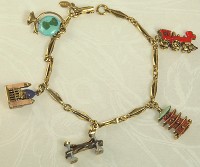 |
|
Gerad Yosca Oriental Themed Charm
bracelet |
|
Charm Ring: A ring
with a charm attached to the band. |
|
Charoite: A silicate
found in Russia it is purple in color and rare. |
|
Chasing: A way to
decorate metal by making indentations with a hammer and a
punch. It is similar to engraving or embossing and it is the
opposite of repoussé. |
|
Chatham Synthetic Ruby:
Introduced in 1959 by Carroll Chatham these are
laboratory created rubies. |
|
Chatelaine: A
chatelaine has a decorative hook that is attached to
waistband and from which hangs chains meant to hold items
such as keys, scissors along with other household items.
The chatelaine was both decorative and utilitarian.
Chatelaine is French for "Lady of the House". |
|
Chaton:
A cone [pointy at the bottom] shaped
rhinestone with a foil backing. |
|
Chaton Setting: See
Arcade Setting. |
|
Chatoyancy: A stone
that changes luster in different lighting much like a cat's
eye effect. They are usually cut in
cabochon shapes to enhance luster. |
|
Chevron Setting: From
the heraldic inverted "V", a chevron setting has lines that
resemble a shallow inverted "V". |
|
Chinese Opal: A
misnomer that is sometimes applied t o moonstone, white
chalcedony and pearl opal.
|
|
Choker: A type of
necklace that fits closely on the neck like a collar. A
choker is usually 14 to 16 inches in length.
|
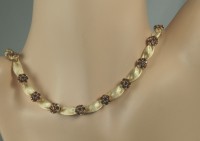 |
|
Trifari Gold Filled Rhinestone Ribbon
Choker |
|
Chrome: A hard and
shiny gray metal that is resistant to corrosion.
|
|
Chrysoberyl: A hard
mineral/gemstone that ranges in color from yellow to green
and brown. Cat's eye and
alexandrite are chrysoberyls. |
|
Chrysolite: A golden
yellow variety of peridot. Also called precious
olivine, it is a mineral that can be found in the
layer below the earth's crust .
|
|
Chrysoprase: A green
variety of chalcedony that is
valued as a gemstone. It is translucent and gets its green
color from nickel. Can range from apple colored to
deep green. 6-7 on the Mohs scale.
|
|
Cinclear:
Marking a piece of silver by using a implement called a "cincel".
Much like a hammer, each cincel has a different edge and
will create a variety of designs.
|
|
Cinnabar: A mineral.
Mercury Sulfide, bright scarlet to brick red in color.
|
|
Cire Perdue: The lost
wax process of casting. The original mold is cast in wax and
coated with clay. When fired the wax melts out leaving a
hollow mold that is filled with molten metal.
|
|
Citrine: From the
French for lemon "citron", it is a semi- precious rare
quartz that can range in color from light yellow, golden
brown to orange. |
|
Claddagh Ring: An
Irish ring that depicts two hands clasped together and named
after a fishing village where the maker of the first one,
Richard Joyce, lived at the time. |
|
Clarity: The lack of
internal flaws that a gemstone has. Clarity of a diamond is
measured with a 10x loupe and graded on a scale from FL or
flawless, meaning perfect to I3, meaning having flaws
or inclusions visible with the naked eye. |
|
Clasp: A fastener
used to connect two ends of a
bracelet,
necklace anklet, watch or a pin to a
garment. Popular types include: Spring ring, toggle, lobster
claw, hook and eye, fold-over and barrel.
|
|
Claw: A prong made of
metal that holds a stone in a setting. |
|
Claw Setting: A
jewelry setting in which a series of claws holds a stone in
place. |
|
Cleavage: The natural
tendency of a stone to break according to it's crystal
structure.
|
|
Cliché: A steel raised
pattern of a design to be made eventually in silver.
|
|
Clip-on: Jewelry
designed to be attached with a clip finding. When referring
to earrings clip-on and clip-back are interchangeable.
|
|
Clip-back Earring: An
earring with a mechanism that opens on a hinge and is
attached to the ear lobe when closed.
|
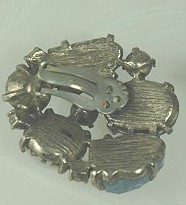 |
|
Schiaparelli
Clip- back Earring |
|
Clip-Mate: A design
registered to Trifari for two clips on one pin back similar
to the Coro Duettes.
|
|
Cloisonné: A type of
enameling [also known as cell enameling] in which
the design is etched into the metal using a metal wire. The
space between the wire is then filled with enamel and fired.
|
|
Closed Setting: A
jewelry setting in which the stone is not exposed on the
back. |
|
Cloud: An inclusion
seen as a milky area in a diamond. |
|
Cluster: A jewelry
setting where several small stones are grouped closely
together. |
|
Cluster Setting: A
jewelry setting in which several smaller stones are set
around a central stone.
|
|
Clutch: A finding that
is slid along a rod to secure an earring or a stick pin.
|
|
Cocktail Ring: An
oversized ring that is set with semi- precious or precious
stones. These rings were popular during the 40s and 50s.
|
|
Cognac Diamond: A
diamond with low nitrogen content, giving it its brown
color. Most are mined in Western Australia.
|
|
Coin Silver: Silver
alloy that is 80% silver and 20% copper. Silver marked "800"
is coin silver. "800" can be found on some European jewelry
and it indicates 800 parts out of 1000 to be silver.
|
|
Collar: A necklace
that usually measures 12 to 13 inches long. Worn close to
the neck, they were popular during the Victorian times.
|
|
Collarette: A short
necklace with flowing ornaments on the front. Also known as
a "bib" necklace.
|
|
Collet: The metal ring
around a bezel set stone that
holds the stone in place.
|
|
Color: In terms of
diamonds color is one of the four "Cs" used to grade a
diamond. The GIA scale goes from colorless to light fancy
[yellowish in color] with colorless being the best.
The letters "D" to "Z" are used with "D" signifying
colorless.
|
|
Colorado Ruby:
Actually a pyrope garnet and not a ruby.
|
|
Comfort Back: A
plastic of rubber pad that is placed on the clip of an
earring to cushion the ear. |
|
Commemorative Wares:
Items that are made to pay tribute to historic events.
|
|
Compact:
A portable cosmetics case that usually had a
mirror and held powder for the face.
|
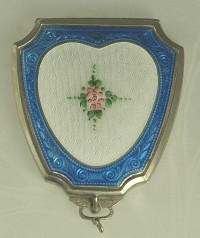 |
|
Elgin America Art Deco Guilloché Compact |
|
Compass Ring: A ring
that rotates and can be used for orienteering. |
|
Composite Suite: An
item of jewelry that can be disassembled into other items of
jewelry.
|
|
Concave: The opposite
of convex it means to curve inward.
|
|
Conch: A mollusk with
a pearly shell that vary in color with pink being the most
prized. Conch is made into cameos and beads.
|
|
Concha: A silver disc
that is used to decorate a belt or bridle. From the Spanish
word for "shell". |
|
Confetti Lucite:
Transparent plastic with glitter or other material embedded
within it.
|
|
Contra Luz Opal:
Transparent opals that are usually faceted and will show
iridescence when light shines through the stone. |
|
Copper:
A reddish
brown element that is common, soft and often used in jewelry
making. Copper is the only metal to appear in large masses.
|
|
Coral:
A marine
organism that lives in colonies in the ocean. It ranges in
color from vivid orange to pale pink. It also comes in red
and black, and white. When used for jewelry it is often
carved into beads or cameos. Imitation coral is made from
glass, plastic or porcelain. Real coral is composed of
calcium carbonate. This will cause a effervescing reaction
if touched with nitric acid. Coral was thought to bring good luck
to the wearer.
|
|
Corallium Rubrum:
Mediterranean red coral.
Considered to be very valuable.
|
|
Cornelian: A
translucent stone with a waxy luster that is a reddish form
of chalcedony. Also called Carnelian or Carneole.
|
|
Cornucopia: Used often
in jewelry, the cornucopia is a symbol of plenty. |
Coro Duettes:
Patented
jewelry sets made by the Coro company. Each has two pin
clips that attaches to a base to be worn as one pin/clip
or removed from the base and worn as two separate
pins/clips.

|
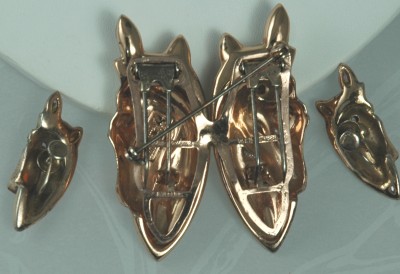 |
|
Reverse of the Famous "Thorobreds" Duette and Earrings
|
|
Coronet:
A small crown worn by a person that ranked lower than a
sovereign in class. |
|
Coronet Setting: A
setting where a stone is held in place be several metal
claws. Also called an
arcade
or chaton setting. |
|
Corundum: The
crystalline form of aluminum oxide it is an extremely hard
[second only to diamonds] rock forming mineral. This family
includes sapphires and rubies. The stones color depends on
the amount of metallic oxide present.
|
|
Costume Jewelry: Jewelry made from less expensive
materials than gemstones and gold or silver. Some costume
jewelry was made in sterling and some had a gold wash over
sterling.
|
|
Cowrie Shell: A marine
shell of the genus Cypraea. These brightly marked and
polished shells are used in jewelry and some were used as
currency in the South Pacific and Africa.
|
|
Cream Powder: Popular
beginning in the 1950s this is face powder that is combined
with oils.
|
|
Crepe
Stone: Glass. Patented by Fowler Brothers,
Providence, RI in 1883. This type of glass is black and has
a crinkled design.
|
|
Crimp Beads: A crimp
bead is used to finish and fasten an end of a cord or a
chain. They are soft metal beads that when squeezed
will shut will fasten the ends of thread onto a clasp.
|
|
Crown: The upper part
of a gemstone. |
|
Crown Glass: Glass
that contains no lead oxide.
|
|
Crown Height: Is the
measurement from the girdle to the table on a diamond or
gemstone. |
|
Crystal - Glass:
Lead Crystal- Glass
of high quality that contains at least 10% Lead Oxide. The
process of making this lead crystal was invented in England
by George Ravenscroft in 1676.
|
|
Crystal-Natural:
Rock Crystal- A
solid whose atoms for a regular structure. Diamonds, quartz
and emeralds are forms of natural crystals.
|
|
Crystalline: A
substance that is either composed of crystals or that
resembles crystals in structure. |
|
Crystallize: To cause
a material to form crystals of to take on the structure of
crystals.
|
|
Cuban Link Chain: A
cable chain with oval links and a twisted rope pattern. |
|
Cubic Zirconia: A
clear and hard lab produced gemstone that resembles a
diamond. Developed in 1977.
|
|
Cuff Bracelet: A wide
and stiff bangle bracelet. |
|
Cuff Link: Closures
for button holes of the cuffs on a long sleeve shirt.
First worn in the 1800s.
Cufflink
types. |
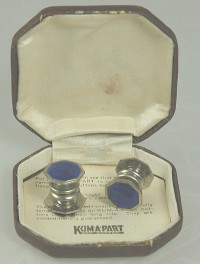 |
|
Baer & Wilde
KUM- A- PART Art Deco Guilloché Cufflinks with Box |
|
Culet: A tiny point at
the bottom of a diamond or other gemstone that keeps the
stone from fracturing.
|
|
Cullinan Diamond: The
largest diamond found so far in its rough form. In
1905 it was mined at the Premier Mine in South Africa. It
was cut into many stone by Joseph Asscher of Amsterdam and
it is also called the "Star of Africa".
|
|
Cultured Pearl: Pearls
that are produced by placing a small irritant into the
opening of a mollusk or oyster. Natural process take over
and the mollusk or oyster will begin to coat the irritant
with nacre. This process was invented by Kokichi Mikimoto.
It can take between five and seven years to produce a
cultured pearl.
|
|
Cupids Darts: Another
name for rutilated quartz. |
|
Curb Link Chain: A
chain that consists of ovals shaped twisted links that are
often diamond cut so that they will lie flat.
|
|
Cushion Cut: A stone
that has been cut with a square shape with rounded edges,
like a cushion. They usually have many facets similar to a
brilliant cute stone.
|
|
Cut: One of the 4 "Cs"
of diamond grading. The most popular cut is the round
brilliant cut. The cut of the diamond will determine it's
fire.
|
|
Cut Beads: Glass beads
that have been faceted.
|
Cut Steel: Used to
produced 18th Century jewels it is steel that has been cut
with many facets and then riveted to a plate of steel or
other metal.
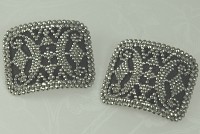 |
|
Victorian Cut Steel Shoe Buckles |
|
Cut Glass: Glass whose
surface has been faceted or grooved or has depressions cut
into it.
|
|
|
|
D |
|
Damascening:
A decorative design process
first used in Damascus of inlaying soft metal such as gold
or silver into harder
metal. |
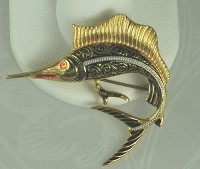 |
|
Damascene Sail Fish |
|
Danalite: A mineral
that occurs in octahedral crystals that is reddish in color. |
|
Dangle Earring: An
earring that dangles below the ear lobe. |
|
Dark Stone: A
rhinestone that has turned black or dark gray in color. |
|
Darya-I-Nur: A
flawless, large, transparent pink diamond. It is from India
originally but is now in Iran in the crown jewels. |
|
Dead Soft: Wire such
as electrical copper wire that is easily bent. |
|
Dead Stone: A
rhinestone with foil backing that is damaged causing the
clear stone to appear yellow, cloudy or dull. |
|
Deco Style: A
descriptive for jewelry or other items that incorporates
design techniques used during the
Deco
period, while not actually being made during that time. |
|
Delft Jewelry: Jewelry
that is made from tin glazed earthenware [Delft
faience] that is usually set in silver and decorated with
hand painted windmills and other Dutch landscapes. Usually
these items are blue, however other colors have been
produced. |
|
Demantoid Garnet: A
form of andradite they are rare, green, lustrous and
valuable garnets that were popular in the 1800s. |
|
Demilune: A stone
shaped like a half-moon. |
Demi-Parure: The term
for two items of matching jewelry.
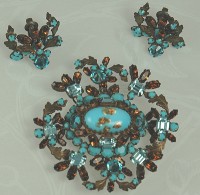 |
|
Schreiner Demi Parure of Brooch and Earrings |
|
|
|
Dendritic: Having a
branching pattern like a tree. |
|
Dentelle: French for
"lace", they are rhinestones cut with 32 or 64 facets. |
|
Deposee: French for
patent. |
|
Diadem: A circular or
semi- circular item of jewelry like a tiara that is worn on
the head. |
|
Diamanté: The term for
a clear rhinestone that looks like a diamond. |
|
Diamond:
The name
derives from the ancient Greek. Diamonds are a transparent
crystal composed of carbon. They are the hardest known
naturally occurring material. They are formed by long
exposure to high temperature and pressure. The caret
weight measures the mass of a diamond. A diamonds value is
based upon the "4 Cs" color, cut, clarity and caret weight. |
|
Diamond Accent:
Jewelry set with small diamonds with a combined caret weight
of less than 1/4 of a caret. |
|
Diamond Cut: When
speaking of diamond cut metal this means that the metal has
been cut into a diamond shape. If speaking of gemstones
diamond cut is the same as brilliant cut. |
|
Diapering: A
crisscross pattern of diamond shaped lines on raised
dotted enamel. |
|
Dichroism: The
property of some crystals to exhibit more than one color
especially when viewed from different angles. Some minerals
such as rubies are naturally dichroic and the effect can
also be artificially produced with a metallic oxide
coating. |
|
Die Stamping: The
process of intaglio engraving. A sheet of metal is cut
and shaped between two dies forming a relief. This process
is also known as "machine stamping". |
|
Dinner Ring: A
cocktail ring. |
|
Disc Earring: A stud
earring that is round and flat and that attaches to the
earlobe with a post and a clutch. |
|
Dispersion: Also known
as "fire", it is the colors or the prism of light that is
emitted from a finished diamond or stone as it is turned. |
|
Dog Collar: A short
multi-strand choker worn close to the neck and usually 14"
to 15" in length. |
|
Dog Tag Jewelry: A
type of necklace that is based upon the dog tags issued to
soldiers, they are flat metal pendants on a ball chain. |
|
Domed: Jewelry that is
convex in shape. |
Door Knocker Earrings:
Earrings that have a section with a hinged bottom that hangs
below the ear lobe.
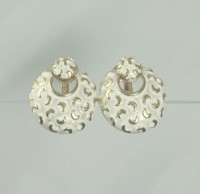
|
Coro White
Enameled Door Knocker Style Earrings
|
|
|
Doublet: A stone
manufactured in two layers to save expenses. The bottom
layer is usually glass or non precious stone while the top
is a precious or more expensive stone. |
|
Doubly Refractive Stone:
When light passes through a doubly refractive stone it is
split into two rays. Tourmaline is an example od such a
stone. |
|
Dress Clip: An article
of jewelry that uses a hinge or prongs to fasten to
clothing. This style of brooch was popular in the 30s and
the 40s. |
|
Dress Set: A suite of
gentleman's accessories that usually includes cufflinks, tie
clips, shirt studs and maybe vest buttons. |
|
Drop: An ornament that
dangles from a piece of jewelry, usually tear drop in shape. |
|
Drop Cut: A pear
shaped stone or briolette with triangular facets at
the top. |
|
Drop Earring: Also
known as a dangle or chandelier earring it is an earring
that hangs below the earlobe. |
|
Druse: A crust of
crystals that line a rock or geode cavity. |
|
Ductile:
A ductile
substance can be easily stretched into thin wire. Gold is
the most ductile metal. |
|
Duettes: A
design registered to Coro that consists of two pins
or clips on
one pin back. This term is now used to describe all such
jewelry. Trifari made similar jewelry called Clip-mates. |
|
|
|
E |
|
Ear Cuff:
A type of earring for non- pierced ears that
pinch onto the ear lobe. They are usually
wide cuff like earrings. Also known as "Huggies". |
|
Earring Back:
Also known as a clutch it is a piece of
metal or plastic with a hole for an earring
post to side through and that holds the
earring on the ear lobe. |
|
Ebonite:
An early rubber produced by adding
sulfur to vulcanized rubber. It is dark,
moldable and hard. Also known as vulcanite.
It is sometimes confused with gutta percha.
Combs and buttons are some of its uses. |
|
Ebony:
A dense, hard and dark wood used sometimes
in jewelry. |
|
Edwardian:
Describes the period of the reign of King
Edward VII in England. 1901-1910. Also known
as Belle Époque. The jewelry of this period
was delicate and utilized filigree,
diamonds, pearls and bows. |
|
Egyptian
Revival: Jewelry that became popular
in the 19th century after the discovery of
several archeological finds in Egypt. The
jewelry was made in the style of the ancient
Egyptians. |
|
Eilat Stone:
A copper based green mineral that is only
found in King Solomon's copper mines Israel. |
|
Electroplate:
A process whereby a less expensive metal is
coated with a more expensive metal using
electricity. Invented by Luigi Galvani. |
|
Electrum:
A naturally occurring alloy of gold and
silver. |
|
Elie Ruby:
These are actually pyrope garnets and
not rubies. |
|
Emboss:
A method of molding, carving or
decorating a surface in relief. |
|
Emerald:
From the beryl family emeralds are hard
green precious stones created when chromium
combines with impurities. Inclusions are
common in emeralds and some are oiled to
lessen the flawed appearance. |
|
Emerald Cut:
A multi-faceted, rectangular cut for
gemstones with shortened corners. This cut
is usually used for diamonds and emeralds. |
|
En Tremblant:
A moving or trembling effect that can
be found on a piece of jewelry usually
achieved by placing and element on a coiled spring. |
|
Enamel:
A powdery glass substance, usually colored
with metal oxides and sometimes applied as a
paste that is fused to metal with
a high degree of heat. The process, called
firing is done in a kiln. This is an
old technique for decorating all types of
items. Enamel is durable enough to be used
in non decorative items such as ovens and
street signs. There are several techniques
including Champlevé and Cloisonné. |
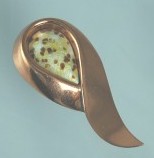 |
|
Matisse Renoir
"Sari" Copper and Enamel Brooch |
|
Engagement
Ring: A ring usually set with a
diamond, however other gemstones are used,
given to a woman by a man to signify intent
to marry. |
|
Engrave:
A method of decorating the surface of
metal by cutting into the surface with a
hard tool. |
|
Enhanced:
Modifying a stone's characteristics
such as color, finish of strength to name a
few. Most gemstones found today have been
enhanced. Common enhancements include:
oiling, bleaching and dyeing. |
|
Estate
Jewelry: Jewelry [usually fine] from
the 50s to present day that was previously
owned. Estate jewelry is also defined as any
pre-owned jewelry that is not costume. This is NOT the same as jewelry
purchased at an estate sale. |
|
Etched:
Decoration that is carved into the surface
of a metal. Can also be achieved by using
chemicals. |
|
Eternity
Ring: A ring with gemstones set
around its entire circumference. |
|
Etruscan
Jewelry: Jewelry made by the ancient
Etruscans who lived in Northern Italy from
the 8th Century B.C. Some techniques
included: granulation and filigree. |
|
Etruscan
Revival: Jewelry inspired by the
archeological finds at Pompeii and
Herculaneum. |
|
Etui:
French for "case". It is a small
decorative case used to hold articles such
as needles, pencils and other items
used in day to day life. Also called a
"necessaire". A type of compact. |
|
European Cut:
An old gemstone cut with a small table and a
heavy crown. It has a round girdle and was
popular from the 1890s to the 1930s. This
type of cut has less brilliance than the
brilliant cut used today. |
|
European
Wire: A curved wire for earrings that
one passes through a hole in the ear lobe
and clasps shut. |
|
Excellent
Condition: A term used by
sellers/dealers of vintage, used, or estate
jewelry to denote jewelry that shows normal
wear consistent with age, no missing parts
or stones and that if restorations were made
they were done impeccably. If stones
are missing they are in a less noticeable
place, such as near a clasp. Please
note that each dealer may use this term
differently. This is our definition at
Amazing Adornments. |
|
Extender
Chain: A chain, usually applied to a
necklace, which increases the length of the
item. |
|
Eyepin:
Used to construct jewelry items, it is a
type of finding that is made of thin wire
with a loop at one end. They come in several
gauges and they are used for stringing and
linking beads. |
|
F |
|
Facet:
The flat surfaces of a cut stone or glass. |
|
False Topaz: A yellow
quartz. |
|
Family Jewel: An item
of jewelry such as a Mothers Ring that is set with family
members birthstones and sometimes names. |
|
Fancy Cut: Also known
as the "Fancy Shape" this is a cut of gemstone that is not
the standard round cut. Some fancy cuts include; pear,
baguette, marquise, rivoli and oval to name a few. |
|
Fancy Diamond: Rare
and valuable diamonds that are blue, green red, yellow
or purple. |
|
Fancy Jasper:
Also known as India Agate. A
gemstone that is opaque and varies on color sometimes within
the same stone. |
|
Fantasy Cut: Faceting
stones using freeform angles. |
|
Fashion Jewelry:
Another name for costume jewelry. |
|
Faux: French for
fake/imitation. |
|
Feather: An inclusion
or internal flaw that may or may not affect the strength and
value of a gemstone. Also called fissures. |
|
Fede Ring: Dating from
the Roman times these are rings that depict two hands
clasped together. Also known as Faith Rings. |
|
Feitsui: The royal
stone of China, it is a highly prized form of jade. |
|
Feldspar: A family of
minerals that includes amazonite, moonstone and sunstone. |
|
Ferrer's Emerald: An
imitation emerald made of glass. |
|
Festoon:
A necklace usually short in length that has
dangles. |
|
Fetish: A decoration
often depicting an animal or a person and is associated with
healing powers. These are usually pendants, charms or
an amulet. |
|
Fibula: Used to fasten
and secure clothing since the times of the ancient Romans
and Greeks. This type of brooch/pin looks like a safety pin
and is often referred to as a safety pin brooch.
|
|
Figural: Jewelry that
is designed to actually look like something such as a
person, animal, flower, leaves and other objects such as
baskets. |
|
Filigree:
Made
from thin wire that is twisted into patterns. The wire
is either soldered to a metal base or the wirework is left
open without the metal backing. The wire is usually gold or
silver. |
|
Figaro Chain: A chain
where the links alternate between on long one and three
round ones. |
|
Figogucci Chain: A
type of mariner chain where the links are diamond cut and
twisted so that they lie flat. |
|
Fimo: Is a polymer
made in Germany that is baked and often made into beads. |
|
Findings: Are parts
such as ear wires, clasps, head and eye pins, hooks and jump
rings used to make jewelry. |
|
Fineness: The
proportion of silver or gold that can be found in a metal
alloy. |
|
Finial: An ornamental
often sculptured knob that sits at the terminal end of
object. |
|
Finish: Describes the
polish or texture that is applied to metal. Some finishes
include: satin, matte, semi-matte, antique, Japanned and
burnished. For diamonds, the finish refers to the polish to
the surface. |
|
Fire: Refers to the
streaks of color within a stone. |
|
Fire Opal: A type of
opal that is usually milky in appearance and that are fiery
orange-red in color. |
|
Fish Hook: A
finding made to be used for
earrings. It is shaped like a fishhook that is threaded
through the hole in the earlobe of a pierced ear. This
is the earliest type of earring finding. |
|
Fissure: A crack in
the surface of a stone. |
|
Flapjack: A slim
compact from the 1930s and 1940s. |
|
Flaw: A crack,
inclusion or other imperfection in a gemstone. |
|
Fleur De Lis: A motif
often used in jewelry it is shaped like an Iris with three
petals. It is French for "flower of the lily" and it is a
heraldic symbol of the French kings. |
|
Floater Necklace: A
necklace where the beads seem to be floating on the neck due
to the way the beads are strung far apart and on
nearly invisible wire. |
|
Florentine Finish:
Also called the brushed finish, it is where parallel lines
are engraved into the surface of the metal in one direction
and then they are crossed with a lighter set of lines. The
metals reflectivity is reduced by this process [it becomes
less shiny]. |
|
Fluorescence: A
property or effect seen in gem quality stones, such as
diamonds, when they are exposed to ultra-violet light. |
|
Fluorite: A soft
mineral composed of calcium fluoride. It is found in many
colors. |
|
Fob: A short ribbon or
chain that is attached to a pocket watch. They are worn
hanging from the pocket and often have a decorative
medallion or an ornament attached to the other end. |
|
Foil: A very thin
piece of metal that is placed behind glass or a crystal to
enhance the brilliance of the stone. |
|
Foil Back: A stone
that has a thin metallic backing that is made out of silver,
gold or a colored foil. This process makes the stone more
reflective of light. Seen in costume jewelry a lot and even
diamonds before cuts such as the brilliant cut were
developed. Water will damage the foil causing
the stone to go "dead" or loose its sparkle.
Stones are rarely foiled these days. |
|
Fold-over Clasp: Used
on a necklace or bracelet to attach the two ends. It is a
device that opens and closes on a hinge. One end is a box
and the other is usually a V shaped tongue. When open there is a bar
that the tongue slips over and then the box is snapped into
place securing the tongue. |
|
Fool's Gold: Pyrite, a
form of iron that looks like gold. Marcasites come from this
shiny metallic mineral. |
|
Forbidden Fruit: A type of jewelry usually pins
made out of Lucite with imbedded rhinestones. Often
the pieces depict fruit. These pieces were most likely
produced during the 1950s in Austria. |
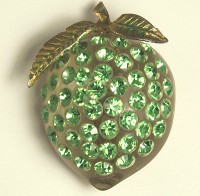 |
|
"Forbidden Fruit" Lime Pin of Lucite and
Green Rhinestones |
|
Fossil Ivory: The tusk
of the extinct Woolly Mammoth. |
|
Fossils: Mineralized
remains of ancient plants and animals. |
|
Fossilized: Organic
matter such as wood or bone that has become petrified over
time. |
|
Four Cs: Cut, Clarity,
Color and Carat Weight. This is a method used to determine a
gemstones quality. |
|
Fracture: A crack or a
feather in a gemstone. |
|
French Ear -wire:
An earring finding that resembles a fishhook. It closes with
a catch and is often used for dangle type earrings.
|
|
French Enamel: Fine
enamel work developed in France in which many layers of thin
colored enamel is applied to metal. This technique was used
by Fabergé. |
|
French Ivory:
Imitation ivory molded from plastic such as celluloid. |
|
French Jet: Glass that
is black in color and made to look like real jet. It is
heavier than real jet and is sometimes carved. |
|
Freshwater Pearl:
Pearls that are shaped like a bumpy grain of rice. They are
harvested from the freshwater mussel which is a mollusk.
Several freshwater pearls can be produced at one time. They
are produced in many countries and they are less valuable
than an than an oyster pearl. |
|
Frost Agate: An agate
that has white markings resembling frost. |
|
Fruit Salad: Costume
jewelry that is set with colorful molded plastic or glass stones. |
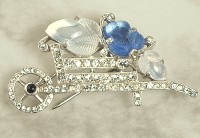 |
|
Trifari Wheel Barrel Clip with Fruit
Salad Stones |
|
Full Cut: A gemstone
with 58 facets. |
|
|